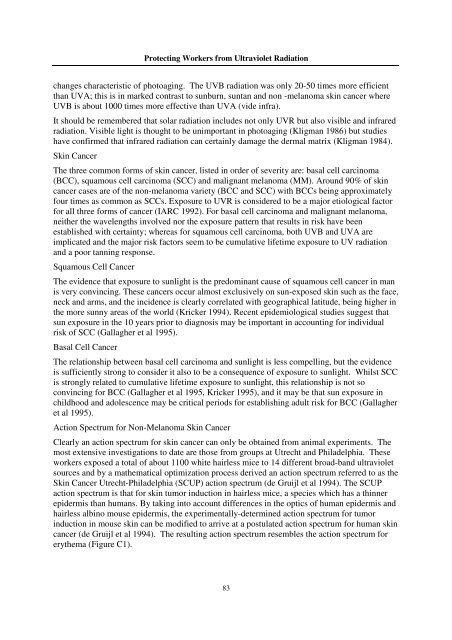Protecting Workers from Ultraviolet Radiation - icnirp
Protecting Workers from Ultraviolet Radiation - icnirp
Protecting Workers from Ultraviolet Radiation - icnirp
Create successful ePaper yourself
Turn your PDF publications into a flip-book with our unique Google optimized e-Paper software.
<strong>Protecting</strong> <strong>Workers</strong> <strong>from</strong> <strong>Ultraviolet</strong> <strong>Radiation</strong><br />
changes characteristic of photoaging. The UVB radiation was only 20-50 times more efficient<br />
than UVA; this is in marked contrast to sunburn, suntan and non -melanoma skin cancer where<br />
UVB is about 1000 times more effective than UVA (vide infra).<br />
It should be remembered that solar radiation includes not only UVR but also visible and infrared<br />
radiation. Visible light is thought to be unimportant in photoaging (Kligman 1986) but studies<br />
have confirmed that infrared radiation can certainly damage the dermal matrix (Kligman 1984).<br />
Skin Cancer<br />
The three common forms of skin cancer, listed in order of severity are: basal cell carcinoma<br />
(BCC), squamous cell carcinoma (SCC) and malignant melanoma (MM). Around 90% of skin<br />
cancer cases are of the non-melanoma variety (BCC and SCC) with BCCs being approximately<br />
four times as common as SCCs. Exposure to UVR is considered to be a major etiological factor<br />
for all three forms of cancer (IARC 1992). For basal cell carcinoma and malignant melanoma,<br />
neither the wavelengths involved nor the exposure pattern that results in risk have been<br />
established with certainty; whereas for squamous cell carcinoma, both UVB and UVA are<br />
implicated and the major risk factors seem to be cumulative lifetime exposure to UV radiation<br />
and a poor tanning response.<br />
Squamous Cell Cancer<br />
The evidence that exposure to sunlight is the predominant cause of squamous cell cancer in man<br />
is very convincing. These cancers occur almost exclusively on sun-exposed skin such as the face,<br />
neck and arms, and the incidence is clearly correlated with geographical latitude, being higher in<br />
the more sunny areas of the world (Kricker 1994). Recent epidemiological studies suggest that<br />
sun exposure in the 10 years prior to diagnosis may be important in accounting for individual<br />
risk of SCC (Gallagher et al 1995).<br />
Basal Cell Cancer<br />
The relationship between basal cell carcinoma and sunlight is less compelling, but the evidence<br />
is sufficiently strong to consider it also to be a consequence of exposure to sunlight. Whilst SCC<br />
is strongly related to cumulative lifetime exposure to sunlight, this relationship is not so<br />
convincing for BCC (Gallagher et al 1995, Kricker 1995), and it may be that sun exposure in<br />
childhood and adolescence may be critical periods for establishing adult risk for BCC (Gallagher<br />
et al 1995).<br />
Action Spectrum for Non-Melanoma Skin Cancer<br />
Clearly an action spectrum for skin cancer can only be obtained <strong>from</strong> animal experiments. The<br />
most extensive investigations to date are those <strong>from</strong> groups at Utrecht and Philadelphia. These<br />
workers exposed a total of about 1100 white hairless mice to 14 different broad-band ultraviolet<br />
sources and by a mathematical optimization process derived an action spectrum referred to as the<br />
Skin Cancer Utrecht-Philadelphia (SCUP) action spectrum (de Gruijl et al 1994). The SCUP<br />
action spectrum is that for skin tumor induction in hairless mice, a species which has a thinner<br />
epidermis than humans. By taking into account differences in the optics of human epidermis and<br />
hairless albino mouse epidermis, the experimentally-determined action spectrum for tumor<br />
induction in mouse skin can be modified to arrive at a postulated action spectrum for human skin<br />
cancer (de Gruijl et al 1994). The resulting action spectrum resembles the action spectrum for<br />
erythema (Figure C1).<br />
83



